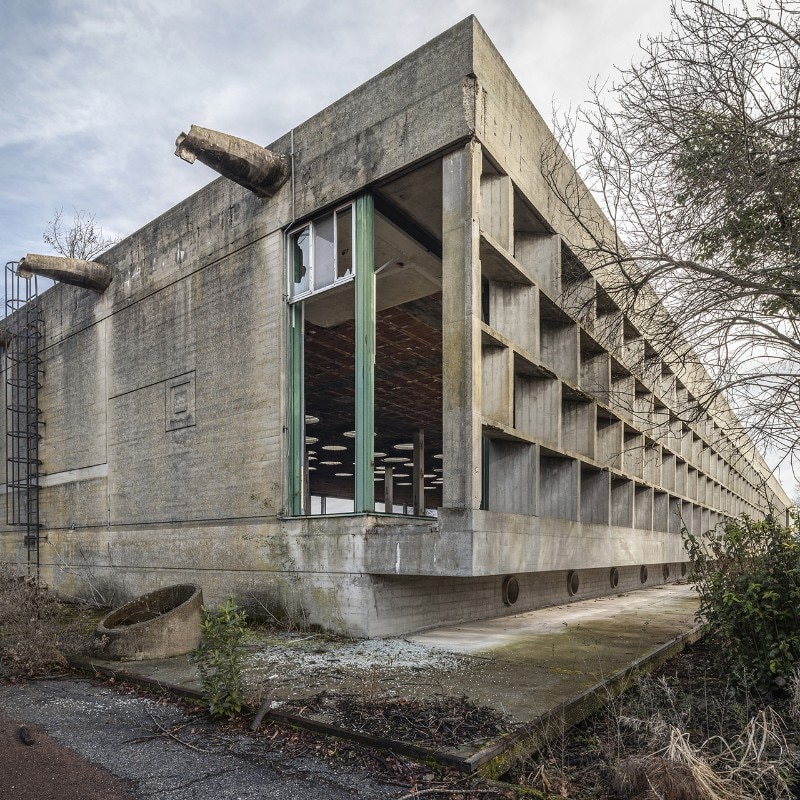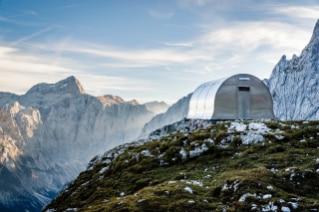-
Sections
-
Keywords
Abandoned architecture in Italy: 11 buildings now disused, but not to be forgotten
01 / 38

Giuseppe Sommaruga, Grand Hotel Campo dei Fiori, Varese, Italy 1912
The feather in the cap of Varese's Belle Époque, the luxurious, late-liberty vacation complex has not withstood the changing times: from hotel, to hospital, then back to hotel again, it was closed in 1968. The gloomy and eerie atmosphere of the place, emphasised by the ravages of time, in 2016 prompted director Luca Guadagnino to set here his version of Dario Argento's famous “Suspiria”.
Photo Julius Barclay from Wikipedia

Giuseppe Sommaruga, Grand Hotel Campo dei Fiori, Varese, Italy 1912
Photo Julius Barclay from Wikipedia

Giuseppe Sommaruga, Grand Hotel Campo dei Fiori, Varese, Italy 1912
Photo Julius Barclay from Wikipedia

Luigi Cosenza, Mercato ittico, Naples, Italy 1935
The fish market in Naples is one of the major examples of the work of Luigi Cosenza, a leading figure in the Neapolitan architectural scene in the first half of the 1900s. Adhering to the principles of Rationalism, the first example in Naples, the covered market consists of a large main trading room and a series of ancillary trading spaces organized along the perimeter. The impressive barrel vault rests on iron reticular arches while the vertical heads of the building and its wide slits are closed by Saint-Gobain glass-cement, in one of the first applications in southern Italy. Although the market is restricted and subject to recovery projects, with reclamation works in progress, recent chronicles report illegal occupation acts.
Archivio Luigi Cosenza_Archivio di Stato di Napoli, Pizzofalcone

Luigi Cosenza, Mercato ittico, Naples, Italy 1935.
Archivio Luigi Cosenza_Archivio di Stato di Napoli, Pizzofalcone

Luigi Cosenza, Mercato ittico, Naples, Italy 1935.
Archivio Luigi Cosenza_Archivio di Stato di Napoli, Pizzofalcone

Renzo Zavanella, Villa dei direttori dello zuccherificio, Sermide (Mantua), Italy 1939
This work by Renzo Zavanella is a refined example of early Rationalism, expressed in the volumetric composition and the definition of the construction details. It was designed between 1931 and 1932 as a residence for the directors of an industrial complex and is characterized by some avant-garde solutions in relation to the typology of the interior spaces, such as the double-height living room and the arrangement of niches to house the built-in wardrobes, and to the technology used, like the insertion of an air gap between the two reinforced concrete walls that form the closures. Studies are still underway for the recovery of this precious architectural testimony.
Photo by Davide Galli Atelier

Renzo Zavanella, Villa dei direttori dello zuccherificio, Sermide (Mantua), Italy 1939
Photo by Davide Galli Atelier

Renzo Zavanella, Villa dei direttori dello zuccherificio, Sermide (Mantua), Italy 1939
Photo by Davide Galli Atelier

Renzo Zavanella, Villa dei direttori dello zuccherificio, Sermide (Mantua), Italy 1939
Photo by Davide Galli Atelier

Mario Loreti, Colonia Varese, Cervia (Ravenna), Italy 1939
Inaugurated with the name of the hierarch Costanzo Ciano, this colony could accommodate up to 800 children. The complex is part of a green area of approximately 60,000 square meters with a planimetric scheme based on rigid symmetry. The central body was used for distribution, while the side pavilions were for dormitories and service spaces. During the war, the building was occupied by the Germans and later fell underused until it was definitively abandoned. Between the 70s and 80s Marcello Aliprandi and Pupi Avati used the Varese colony as a set for the films La ragazza di latta and Zeder.
Foto by Roberto Conte

Mario Loreti, Colonia Varese, Cervia (Ravenna), Italy 1939
View article

Alberto Galardi, Istituto Marxer, Loranzè (Torino), Italy 1962
The Marxer Institute is a rare example of brutalist architecture in Italy, commissioned by Adriano Olivetti to house production and research in the pharmacological field for the homonymous company. The complex is divided into two main volumes, which housed offices, research laboratories, and the production plant, and an existing building with the canteen and other functions. From the end of the seventies, the socio-economic transformations led to several changes of ownership and progressive underuse along with degradation processes fueled by the action of time and by acts of vandalism.
Photo by Roberto Conte



Alberto Galardi, Istituto Marxer, Loranzè (Torino), Italy 1962
Domus 394, September 1962

Giuseppe Davanzo, Foro Boario, Padova, Italy 1968
The Foro Boario was created to host livestock trading, exchange, and exhibition. The structural conception based on the iteration of a horizontal and vertical geometric module generates a large, bright, and airy covered space, whose architectural quality has earned various acknowledgments such as the In/Arch Award in 1969, the interest of the MoMA of New York, and a relatively premature monumental constraint as an element of active qualification and an episode of extremely high emergence in the surrounding urban environment, defined in a totally new way. Once the city's project to establish an international forum collapsed, this cathedral, as it was called by many, fell into disuse and is today at the center of interest of the Lille multinational Leroy Merlin.
Photo by Roberto Conte




Giovanni Giannattasio Ufo Bar, Salerno, Italy, 1970s
The Ufo Bar was a small, today abandoned, nightclub on the coastal road out of Salerno, shortly after the Arechi stadium and near a service station. The building designed by Giovanni Giannattasio has the shape of a spherical cap pierced by small portholes. Two oblique walls mark the entrance and, once crossed the threshold, it seems to enter some Tatooine tavern from Star Wars. Theater of the Salerno nightlife until the end of the 1990s, the Ufo Bar has ceased activity since the authorities affixed the seals after some illegal activities were found upon inspections.
Photo by Roberto Conte



Dante Bini, La Cupola, Sassari, Italy 1970
The dream of a house by the sea on the shores of a wild coast and the meeting with a visionary architect led to the conception and construction of a futuristic building: a sphere in reinforced concrete inextricably integrated into the surrounding marine landscape. The Binishell patent convinces a couple, director Michelangelo Antonioni and the actress Monica Vitti, to rely on Dante Bini to realize their home in Sardinia. The house is built in a single casting of concrete using air pressure. The conclusion of the relationship between Antonioni and Vitti created the conditions for gradually abandoning the structure and the inevitable deterioration.
Domus 1026, July2018



Aldo Rossi e Gianni Braghieri, Stazione di Milano San Cristoforo, Milano, Italy 1983.
The expansion of the San Cristoforo station was commissioned to build a terminal for the transport of private cars along the Milan-Paris line. The construction was never completed due to the client's constant rethinking until the definitive abandonment of the works in 1991. Today we can virtually read the masses of the ruined skeleton and imagine the transit of vehicles in the area in front. The debate on the future of this unfinished building is destined to continue in the years to come in light of the transformation program affecting the Milanese railyards.
Photo by Gerardo Semprebon

Aldo Rossi e Gianni Braghieri, Stazione di Milano San Cristoforo, Milano, Italy 1983.
Photo by Gerardo Semprebon

Aldo Rossi e Gianni Braghieri, Stazione di Milano San Cristoforo, Milano, Italy 1983.
Photo by Gerardo Semprebon

Aldo Rossi e Gianni Braghieri, Stazione di Milano San Cristoforo, Milano, Italy 1983.
Photo by Gerardo Semprebon

Consonno (Lecco), Italy 1960s
It was the early 1960s when the entrepreneur Mario Bagno bought the land in the district of Consonno and razed the few houses abandoned after the crisis in the agricultural sector to build a new Toyland. Focused on the tourism industry, Consonno housed shops, restaurants, sports fields, a dance hall, a luxury hotel, an amusement park, a zoological garden, a medieval castle as an entrance gate, and the notorious minaret. In 1966, the first of two landslides that would have marked the future of this place within ten years, isolated the town, showcasing the consequences of excessive overbuilding and land taking. It was the beginning of a gradual abandonment that turned the themed village into a ghost town.
Photo on Wikicommons



Vico Magistretti, Housing complex at Marina Grande, Arenzano (Genova), Italy 1065
The complex was built as a real estate initiative commissioned by Cemadis S.p.A. acronym of Centro Marittimi di Soggiorno, against the backdrop of the urbanization plan of the Arenzano pine forest. The 300 meters of shops, streets, public spaces, services, car parks, and residences are organized on basements connecting the different coast levels and above-ground blocks organized around courtyards and patios shaped to maintain controlled scalar relationships. Over the years, the residents have gradually abandoned the structure, leaving the public spaces for the use of bathers and passers-by. The presence of several owners with heterogeneous interests has contributed to slowing down the initiatives for functional recovery.

Vico Magistretti, Housing complex at Marina Grande, Arenzano (Genova), Italy 1965
View article

